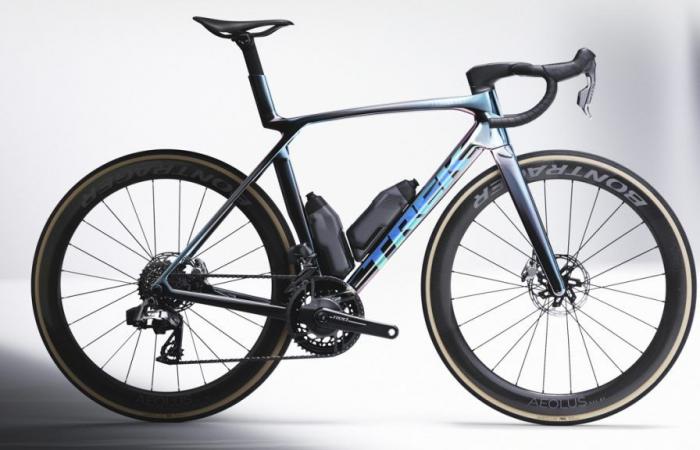The official presentation is today new Trek Madone Gen 8.
Already used for several weeks by the Pros of the Lidl-Trek Team, it is a revolutionary bike not so much and not only for its technical characteristics, but because it upsets the philosophy carried forward by the American brand in recent years: no longer two specific (and very different) bikes for climbing and fast routes, but a single bike good for doing everything.
The new Trek Madone Gen 8, in fact, replaces both the Emonda (with the exception of the aluminum version) and the Madone Gen 7 launched 2 years ago. A simplification of the range that seems to arise from the requests of the Pros, but that certainly meets the needs of the market and users, who in this way will no longer have to choose between one model or the other (because let’s face it, who could afford to keep a climbing bike and an aero one in the garage based on the type of outing?).
Trek presents it as the definitive bike, as light as the Emonda, as fast as the Madone Gen 7. But beyond the proclamations, while we wait to test it on the road (one is arriving right now) let’s see what its salient technical characteristics are.
New OCLV 900 carbon and new tube shapes
The eighth-generation Trek Madone SLR features new aerodynamic tube shapes with Full System Foil profiles, but above all the use of the OCLV 900 series carbon. This mix allowed us to maintain almost the same weight as the Emonda and save 320 grams compared to the Madone Gen 7 frame kit.
At the same time, according to data provided by Trek, the new Madone Gen 8 has the same aerodynamic performance as the previous Madone and at 200 watts is 77 seconds per hour faster than the Emonda (with the same rider position used on the Gen 7 Madone).
900 OCLV Carbon features an optimized manufacturing process, which allows for the use of less material, saving weight, while still offering 20% resistance more compared to the previous OCLV 800.
The declared weight of the SLR frame alone, unpainted, in size M/L is 765 grams.
An interesting novelty also concerns the forknow made in a single piecealways with OCLV 900 carbon.
SL versions of the Madone will continue to be produced with OCLV 500 carbon.
Integrated Aero RSL handlebar Road
As with the Madone Gen 7, an integral part of the project is the carbon cockpit, which takes the name of Aero RSL Road.
This too is designed with the new Full System Foil aero profiles, it is lighter and more ergonomic than that of the Madone, but offers the same shapes: 80 mm reach, 124 mm drop and a pronounced flare corresponding to a good 3 cm difference between the top and bottom of the fold. This is a setting that helps the rider maintain a more aerodynamic position and, honestly, we really liked it when testing the Madone Gen 7.
Improved IsoFlow system
The much discussed IsoFlow system is also confirmed on the new Trek Madone Gen 8, but has been modified to obtain a further improvement in comfort and a reduction in weight. In particular, the shapes of the tubes have changed and the size of the hole has been reduced.
Trek claims that the new IsoFlow system has the ability to absorb vertical stresses 80% better than the previous Madone e by 24% compared to Emonda. Compared to the latter it allows an aerodynamic improvement thanks to the reduction of the turbulence typical of this area of the bike.
New Trek Madone Gen 8: Specs and Details
The concept of aerodynamics no longer concerns just the frame+fork, but the entire bike+athlete system.
The integrated handlebar that helps the cyclist to maintain a more efficient position goes in this direction, but also the introduction of the new bottle cages and new RSL Aero bottles.
As you can see from the infographic below, water bottles and bottle cages at an aerodynamic level become a single body with wheels, down tube and seat tube, thus offering further advantages.
The RSL Aero bottle cages are also compatible with round bottles, which however will partially limit the aerodynamic improvements. RSL Aero water bottles and bottle cages are supplied as standard with the SLR versions of the new Madone, but they can also be purchased aftermarket and mounted on other bikes, given that according to Trek they also offer considerable advantages on other models.
Moving on to other details, the new Trek Madone is equipped with UDH dropout and threaded bottom bracket with standard T47.
Il maximum wheel clearance is 32 mmbut the bikes are fitted with 28mm tyres.
The seat post, although slimmer, features the same system as the current Madone. It is available in 4 different lengths and with different setbacks.
Fewer sizes, revised geometries
Important news also concerns sizes, which go from 8 to 6 and that now, as in the MTB field, are indicated with letters and no longer numbers. According to Trek, the reduction in available sizes does not compromise wearability and fitting, thanks to a revision of the geometry. Indeed, according to what the American company declared, the smallest and largest sizes are able to satisfy even the smallest and very tallest cyclists.
Compared to the Madone Gen 7, the geometry is less extreme, with an average shorter reach and a higher stack, therefore very similar to that of the “old” Emonda.
In any case, to better understand how the transition between old and new sizes was designed, we suggest you take a look at the infographic below:
Another noteworthy aspect is that the dimensions, but also the profiles of the tubes, change according to the size. A solution that not only allows to maintain constant rigidity and riding feeling from one size to another, but also aerodynamic performance.
Below you will find the new size chart in detail:
What are the differences between SLR and SL?
Even with the new Madone Gen 8 Trek maintains the distinction between the SLR version (the most premium and lightest) and the SL version (heavier, but less expensive).
Let’s see in summary what the main differences are:
- the new Madone SLR is made with 900 OCLV Carbon, the SL with 500 OCLV Carbon. On the frame kit the weight difference is 250 grams, but it is worth noting that the new Madone SL is 175 grams lighter than the previous Emonda SL;
- the SLR version is equipped with the integrated Aero RSL handlebar, the SL with a handlebar + stem combo;
- the Madone SLR comes standard with RSL Aero bottles and cages, while the SL does not include them (but can be purchased separately);
- the Madone SLR is available in both standard trim levels and in a customizable version via Project One. Project One is not available for the Madone SL;
- The SLR version is compatible exclusively with electronic transmissions, while the SL can also fit mechanical groupsets.
New Trek Madone Gen 8: models and prices
The new Trek Madone Gen 8 will be offered in 8 versions (4 SLR and 4 SL), in addition to the frame kits, available for both the SL and the SLR.
Prices start from 3,589 euros of the Madone SL5 mounted with Shimano 105 mechanical and arrive at the 13,999 euros for the Madone SLR 9 AXS with the new Sram Red AXS.
Il kit frame SLR costa 5.129 eurothe SL one 3.069 euro.
For the weights and prices of all models we refer you to this article.
For more information: trekbikes.com






